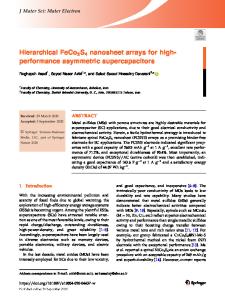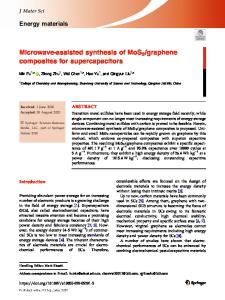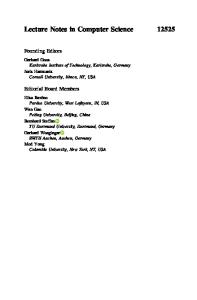Multiscale porous graphene oxide network with high packing density for asymmetric supercapacitors
- PDF / 788,529 Bytes
- 12 Pages / 584.957 x 782.986 pts Page_size
- 19 Downloads / 449 Views
Serguei V. Savilov and Valery V. Lunin Department of Chemistry, M. V. Lomonosov Moscow State University, Moscow 119991, Russia
Hui Xiab) School of Materials Science and Engineering, Nanjing University of Science and Technology, Nanjing 210094, China; and Herbert Gleiter Institute of Nanoscience, Nanjing University of Science and Technology, Nanjing 210094, China (Received 26 September 2017; accepted 14 November 2017)
In this article, we report the synthesis of highly packed graphene oxide-based electrodes (1.25 g/cm3) with a three-dimensional multiscale porous structure (denoted as MPGP) through the ZnO nanodisk (100–500 nm) template and subsequent H2O2 treatment. Consequently, MPGP with a macropore diameter of 100 nm and a mesopore diameter of 2–3 nm was fabricated as the electrode for supercapacitors (SCs). Significantly, the MPGP achieves a high-volumetric capacitance of 327 F/cm3 (262 F/g) at a current density of 1 A/g and retains 240 F/cm3 (192 F/g) at a current density of 16 A/g in 3 M KOH solution. More importantly, it was also capable of delivering a high-volumetric energy density as well as power density in a SC device. Our work shows that the capability of preparing highly packed graphene-based electrodes with highvolumetric as well as specific capacitance is critical for the application of SCs.
I. INTRODUCTION
The rapidly increasing commercial electronic device market and application of renewable but intermittent energy supplies (e.g., sunlight, wind, and tide) give rise to a high demand of highly efficient electrochemical energy storage devices that can provide large energy density as well as high-power density simultaneously.1–5 Supercapacitors (SCs), also known as electrochemical capacitors, have attracted intensive attention in decades for its capability of storing and delivering energy in seconds. Generally, the SCs are able to deliver 1–2 orders of magnitude higher in power density than Li ion batteries (LIBs), 2–3 orders of magnitude better in superior cycle lifetime than LIBs, and almost 3–4 orders of magnitude larger in energy density than conventional capacitors. Based on the energy storage mechanisms of SCs, two major categories were classified. One is the pseudocapacitor, where the capacitance comes from the fast and reversible faradic reactions taken place at surface and near surface of pseudocapacitive materials.6,7 Despite
Contributing Editor: Tianyu Liu Address all correspondence to these authors. a) e-mail: [email protected] b) e-mail: [email protected] DOI: 10.1557/jmr.2017.449
high-theoretical capacitance raised from pairs of redox species, the practical capacitance of pseudocapacitive materials at high-charge/discharge rates is limited by the poor electronic and ionic conductivity.8 Alternatively, the other category based on electrical double layer (EDL) materials is able to be charged and discharged more rapidly than pseudocapacitive materials due to their high conductivity.9,10 The capacitance of EDL materials originates from the charge accumulation at the electrode/ electro
Data Loading...











